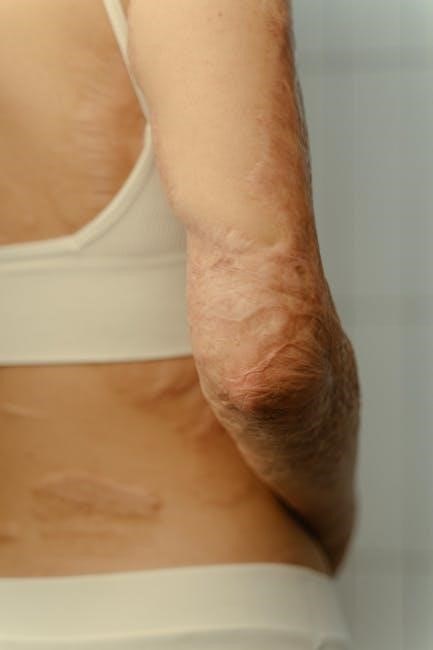Guided Tissue Regeneration (GTR) is a surgical procedure that promotes bone growth in deficient areas, enhancing dental implant placement success by using barriers to direct tissue regeneration.
1.1. Definition and Purpose of GTR
Guided Tissue Regeneration (GTR) is a dental surgical procedure that uses barriers to guide the growth of new tissue in areas with bone defects. Its primary purpose is to treat bone loss caused by conditions like periodontal disease or trauma, enabling successful dental implant placement. By preventing unwanted cells from invading the healing area, GTR promotes bone regeneration. This technique is essential for restoring jawbone structure, ensuring proper implant stability, and improving both functional and aesthetic outcomes for patients.
1.2. Importance in Dental Procedures
Guided Tissue Regeneration (GTR) is crucial for addressing bone defects that hinder dental implant placement. By promoting bone growth, GTR restores lost jawbone structure, ensuring implants are securely anchored. This procedure is vital for patients with severe bone loss due to periodontal disease or trauma. GTR not only improves the functionality of dental implants but also enhances aesthetic outcomes. Its ability to regenerate bone tissue makes it a cornerstone in modern dental surgery, offering long-term solutions for patients seeking durable and natural-looking results. Without GTR, many patients would not qualify for implants, making it indispensable in contemporary dental care.

Factors Influencing GTR Cost
Geographical location, extent of bone defect, materials used, and surgeon expertise significantly impact GTR cost, making it variable across regions and patient-specific needs.
2.1. Geographical Location
Geographical location significantly influences GTR cost due to variations in living costs, surgeon fees, and facility charges. In urban areas, higher demand and overhead expenses often result in increased prices. Additionally, regions with specialized dental clinics or advanced medical facilities may charge more for procedures. Conversely, smaller towns or countries with lower cost-of-living indexes may offer more affordable GTR treatments. Insurance coverage and local healthcare policies also play a role in determining final costs, making it essential to research regional pricing and financial options before proceeding with GTR surgery.
2.2. Extent of Bone Defect
The extent of the bone defect directly impacts the cost of GTR. Larger or more complex defects require additional materials, such as membranes, grafts, and barrier devices, increasing expenses. The size and depth of the defect also influence surgical time, as more extensive repairs demand greater precision and effort. Furthermore, the shape and location of the defect may necessitate specialized approaches, further driving up costs. Patients with severe bone loss often face higher bills due to the need for multiple procedures or advanced techniques to ensure successful regeneration. This variability makes the defect’s scope a critical cost determinant in GTR procedures.
2.3. Type of Materials Used
The type of materials used in GTR significantly influences the cost. Resorbable membranes, non-resorbable membranes, and bone graft substitutes vary in price. High-quality, advanced materials, such as collagen membranes or synthetic polymers, are more expensive but offer better biocompatibility and performance. Bone graft materials, including autografts, allografts, or xenografts, also affect costs due to their sourcing and processing. Additionally, the use of combination products, like membrane-graft hybrids, can increase expenses. The choice of materials balances cost, efficacy, and patient-specific needs, making it a key factor in determining overall GTR expenses.
2.4. Surgeon’s Expertise and Facility Fees
The surgeon’s expertise and facility fees significantly impact GTR costs. Experienced surgeons with specialized training may charge higher fees due to their skill in achieving optimal results. Similarly, the facility’s reputation, location, and equipment quality influence costs. Advanced clinics with state-of-the-art technology often have higher fees compared to smaller practices. While these costs can be substantial, they reflect the expertise and resources required for successful GTR procedures. Patients should consider both the surgeon’s qualifications and facility standards when evaluating affordability and value.

Average Cost of GTR
The average cost of GTR varies widely, ranging from $500 to $3,000 or more per site, depending on the complexity and materials used in the procedure.
3.1. Cost in the United States
In the United States, the cost of Guided Tissue Regeneration (GTR) typically ranges from $500 to $3,000 per site, depending on the complexity of the procedure. Factors such as the size of the bone defect, the type of barrier membrane used, and the surgeon’s expertise can influence the final cost. Additionally, facility fees and the need for follow-up care may add to the overall expense. While GTR is a significant investment, it is often considered a valuable step in achieving successful dental implant placement and long-term oral health outcomes for patients with severe bone loss.
3.2. Cost in Europe
In Europe, the cost of Guided Tissue Regeneration (GTR) typically ranges between €400 to €2,500 per site. Factors such as the extent of bone loss, the type of materials used, and the surgeon’s expertise influence the final cost. Regional variations exist, with some countries offering more affordable rates due to different healthcare systems and regulations. Clinic fees and follow-up care can also contribute to the overall expense. Patients should consult with their dental specialists to get a precise estimate tailored to their specific needs for accurate financial planning.
3.3. Cost in Asia
The cost of Guided Tissue Regeneration (GTR) in Asia varies significantly, ranging from $200 to $1,500 per procedure. Countries like India and Thailand often offer more affordable rates due to lower labor costs and clinic fees. Advanced clinics in regions like South Korea or Singapore may charge higher due to cutting-edge technology and expertise. Materials used, such as resorbable membranes, can also impact the total cost. Patients seeking cost-effective solutions frequently explore options in Southeast Asia, where high-quality care is available at competitive prices. Consulting with local dental specialists is recommended for precise pricing tailored to individual needs.
Detailed GTR Procedure
Guided Tissue Regeneration (GTR) involves a surgical procedure where a resorbable membrane is placed over the bone defect to promote new tissue growth, followed by suturing and healing.
4.1; Step-by-Step Explanation
The GTR procedure begins with a thorough examination and diagnosis, followed by anesthesia administration. A surgical incision is made to expose the bone defect. A resorbable membrane is then carefully placed over the defective area to guide tissue regeneration. The membrane prevents soft tissue ingrowth, allowing bone cells to populate the defect. Suturing is done to secure the membrane and close the incision. Post-surgery, healing is monitored to ensure proper bone regeneration, typically taking several months before implant placement. This structured approach ensures optimal bone repair and successful dental restoration.
4.2. What to Expect During Surgery
During GTR surgery, patients are typically under local anesthesia to minimize discomfort. The procedure involves making a small incision in the gum to access the bone defect. A biocompatible membrane is placed over the defective area to prevent soft tissue invasion, promoting bone regeneration. The surgery is usually completed within 1-2 hours, depending on the defect’s complexity. Patients may experience mild swelling or discomfort post-surgery, managed with prescribed medication. The membrane is resorbed over time, and follow-up appointments are scheduled to monitor healing progress and ensure proper bone growth for successful implant placement.
Comparison with Other Bone Grafting Methods
Guided Tissue Regeneration (GTR) differs from traditional bone grafting by using biocompatible barriers to direct bone growth, offering a minimally invasive approach with potentially lower costs and faster recovery.
5.1. Traditional Bone Grafting
Traditional bone grafting involves transferring bone from one part of the body or a donor to the deficient area. This method is effective but invasive, requiring longer recovery times and higher costs compared to GTR. The surgical complexity, graft source, and post-operative care contribute to its expense. However, it remains a reliable option for extensive bone defects, ensuring structural integrity and durability. While GTR offers a modern alternative, traditional bone grafting is still widely used for complex cases where significant bone volume is needed.
5.2. Alternative Methods and Their Costs
Alternatives to GTR include bone grafting techniques like allografts, xenografts, and synthetic materials. Allografts, using donor bone, are cost-effective but may have lower success rates. Xenografts, derived from non-human sources, offer a natural scaffold for regeneration at a moderate cost. Synthetic grafts, made from materials like hydroxyapatite or titanium, are more expensive but provide consistent results. Each method varies in cost based on material source, surgical complexity, and patient needs. While these alternatives are often cheaper than GTR, they may lack its precision and effectiveness for complex bone defects, making GTR a preferred choice for optimal outcomes in certain cases.

Insurance Coverage andFinancial Considerations

Insurance Coverage and Financial Considerations
Insurance coverage for GTR varies, often covering medically necessary procedures but not elective ones. Patients may face out-of-pocket costs, emphasizing the need for financial planning.
6.1. When GTR is Covered by Insurance
Insurance typically covers GTR when it’s deemed medically necessary, such as repairing bone defects that affect health, like chewing or supporting dental implants. Cosmetic procedures are usually excluded. Pre-approval is often required, with treatment plans submitted for review. Significant defects impacting function are more likely covered, while minor ones may not be. Coverage varies between medical and dental insurance, with GTR as part of necessary surgeries potentially covered. Standalone procedures for non-essential reasons are often denied. Specific policy clauses may affect coverage, so checking individual terms is crucial.
6.2. How to Check Insurance Coverage
To determine if GTR is covered by your insurance, start by contacting your provider directly. Request detailed information about your policy, focusing on sections related to surgical procedures and bone regeneration. Review your plan documentation to identify specific coverage criteria. Submit your treatment plan, including a doctor’s diagnosis and recommended procedure, for pre-approval. Compare the outlined benefits with the estimated costs of GTR to understand your financial responsibilities. Keep records of all communications and decisions for future reference. This process ensures clarity on what is covered and helps avoid unexpected expenses.
6.3. Appealing Insurance Decisions
If your insurance claim for GTR is denied, you can appeal the decision by submitting additional documentation. Start by reviewing your policy to understand the criteria for coverage. Provide a detailed treatment plan from your dentist or surgeon, emphasizing the medical necessity of GTR. Include a letter from your healthcare provider explaining why the procedure is essential for your oral health. Follow the insurer’s formal appeals process, which may involve filling out specific forms or attending a review meeting. Keep records of all communications and decisions for reference. Seeking guidance from your dentist or a patient advocate can also strengthen your case during the appeal process.
Payment Options and Financing
Payment plans, third-party financing, and credit options are available to make GTR affordable. Many clinics offer discounts for upfront payments or financing strategies to ease financial burdens.
7.1. Available Financing Strategies
Patients can explore various financing options to manage GTR costs. Credit cards, bank loans, and third-party financing companies specialize in medical expenses. Many clinics offer payment plans, allowing patients to pay in installments. Some providers also accept insurance coverage for medically necessary procedures. Additionally, discounted packages or upfront payment incentives may be available. Financing strategies vary by provider, so it’s essential to discuss options during initial consultations. These solutions help make GTR more accessible and affordable for individuals seeking advanced dental care.
7.2. Payment Plans and Discounts
Many dental clinics offer flexible payment plans tailored to individual budgets, allowing patients to distribute GTR costs over time. Discounted rates are often available for upfront payments or bundled procedures. Seasonal promotions, new patient specials, and referrals can further reduce expenses. Some practices partner with financing companies to provide low-interest or interest-free options. Patients are encouraged to inquire about these opportunities during consultations to maximize savings and ensure affordability without compromising on quality care.

Recovery and Aftercare
Proper post-surgery care ensures optimal healing. Patients should rest, avoid strenuous activities, and follow prescribed medication regimens. Regular follow-ups with the surgeon are essential for monitoring progress and addressing concerns promptly.
8.1. Immediate Post-Surgery Care
After GTR surgery, patients should rest and avoid strenuous activities for 24-48 hours. Swelling and discomfort are common, managed with prescribed pain medication. A soft diet is recommended for 1-2 weeks to protect the surgical site. Patients must rinse with saline solution to maintain hygiene and prevent infection. Smoking and alcohol should be avoided to promote healing. Follow-up appointments are crucial to monitor progress and remove sutures. Adhering to the surgeon’s instructions ensures proper recovery and minimizes complications. Immediate post-surgery care is vital for achieving the best outcomes in guided tissue regeneration.
8.2. Long-Term Recovery Tips
For long-term recovery after GTR, maintaining good oral hygiene is essential to prevent infection and promote healing. Patients should avoid smoking and heavy alcohol consumption, as these can hinder bone regeneration. A balanced diet rich in vitamins and minerals supports tissue repair. Regular follow-up appointments with the surgeon are crucial to monitor healing progress. Avoiding strenuous activities for several weeks post-surgery is recommended to minimize stress on the surgical site. Proper care ensures optimal results and longevity of the regenerated tissue, supporting successful dental implant placement and overall oral health.

Long-term Benefits and Value
GTR offers lasting benefits, including improved dental function, enhanced aesthetics, and better quality of life by restoring bone structure and supporting successful implant placement.
9.1. Success Rates of GTR
GTR has shown high success rates, typically ranging from 85% to 95%, depending on the defect’s complexity and patient-specific factors. The procedure’s effectiveness lies in its ability to regenerate lost bone tissue, ensuring optimal conditions for dental implants. Success is measured by bone volume increase, implant stability, and long-term functional outcomes. Proper material selection and surgical expertise significantly influence these rates. Patients with adequate healing capacity and adherence to post-operative care often achieve the best results, making GTR a reliable and durable solution for bone reconstruction in dental procedures.
9.2. Cost vs. Longevity of Results
GTR offers a favorable balance between cost and longevity, as its durable results often negate the need for repeat procedures. While initial expenses may seem high, the long-term benefits justify the investment. Patients typically experience lasting bone regeneration, supporting dental implants for decades. The cost-effectiveness is evident in reduced future interventions and sustained oral health. Thus, GTR is a valuable option for those seeking a permanent solution to bone defects, providing both financial and clinical advantages over time.

Tips for Reducing GTR Costs
Compare surgeons and facilities for competitive pricing, check insurance coverage, and explore financing options. Discounts for multiple procedures or bundled services may also lower expenses significantly.
10.1. Considering All Options
Exploring various treatment options and comparing costs can help reduce expenses. Patients should discuss with their surgeons alternative materials or techniques that may lower fees without compromising results. Additionally, considering clinics that offer package deals or discounts for multiple procedures can be cost-effective. Insurance coverage should also be thoroughly reviewed to maximize benefits. Financing plans and payment options can make GTR more affordable, ensuring that patients receive quality care while staying within their budget. Researching and comparing different providers can lead to significant savings.
10.2. Cost-Effective Strategies
To reduce GTR costs, prioritize treating only necessary areas and opt for synthetic bone graft materials, which are often more affordable than natural ones. Seeking a second opinion can also help identify cost-saving opportunities. Timing the procedure during slower periods may lead to discounts. Additionally, negotiating payment terms or bundled pricing with clinics can lower expenses. Exploring financing options like interest-free plans or sliding-scale fees can make GTR more accessible. By carefully planning and researching, patients can achieve desired outcomes while managing costs effectively.

Potential Risks and Complications
Common risks include membrane exposure, graft failure, and infection. Nerve damage and swelling may occur. Proper aftercare minimizes these complications effectively.
11.1. Common Risks
Common risks associated with GTR include membrane exposure, graft failure, and infection. These complications can arise from poor surgical technique or inadequate post-operative care. Membrane exposure is a frequent issue, potentially leading to graft contamination and failure. Infection risks are elevated in cases of improper wound management. Additionally, swelling, bruising, and nerve damage are possible, though less common. Patients with compromised healing abilities, such as diabetics, face higher risks. While severe complications are rare, they can significantly impact the success and cost of the procedure, necessitating additional treatments or revisions.
11.2. Managing Complications
Managing complications in GTR requires prompt and targeted interventions. If a membrane is exposed, surgical debridement or partial removal may be necessary to prevent infection. Antibiotics are often prescribed to address or prevent bacterial issues. In cases of graft failure, additional surgeries or alternative grafting methods may be required. Proper wound care and follow-up appointments are crucial to minimize risks. Patients should adhere to post-operative instructions, such as avoiding smoking and maintaining oral hygiene, to support healing. Early detection and treatment of complications can help reduce the need for costly revisions and ensure a successful outcome.

Future of GTR
The future of GTR lies in advancements like biocompatible materials and minimally invasive techniques, potentially reducing costs and improving accessibility for patients worldwide.
12.1. Emerging Technologies
Emerging technologies in GTR include advanced biocompatible materials, 3D-printed scaffolds, and growth factor-enhanced membranes. These innovations aim to improve bone regeneration efficiency and reduce healing times. Researchers are also exploring stem cell therapy to accelerate tissue repair. Additionally, minimally invasive surgical techniques and digital planning tools are being developed to enhance precision and accessibility. These advancements could lower costs by reducing the need for multiple procedures and shorten recovery periods. As these technologies mature, they promise to make GTR more affordable and effective, benefiting patients globally. The integration of nanotechnology and bioengineering further highlights the potential for groundbreaking advancements in this field.
12.2. Potential Cost Changes
Advancements in technology and materials may lead to reduced costs for GTR procedures in the future. As biocompatible materials and 3D-printed scaffolds become more widely available, production expenses could decrease, making treatments more accessible. Additionally, economies of scale from increased adoption of GTR could lower prices. However, rising demand for specialized surgeons and facilities might offset these reductions. Insurance coverage expansion could also influence affordability, potentially reducing out-of-pocket costs for patients. Overall, while costs may fluctuate in the short term, long-term trends suggest a more cost-effective future for GTR, balancing innovation with patient accessibility.
Guided Tissue Regeneration (GTR) is essential for addressing bone defects, with costs varying by location and materials, but innovations may reduce expenses, ensuring long-term dental health solutions.
13.1. Summary of Key Points
Guided Tissue Regeneration (GTR) is a critical procedure for addressing bone defects, with costs influenced by factors like location, defect severity, materials, and surgeon expertise. While expenses vary globally, advancements in technology and materials aim to enhance affordability and accessibility. Patients should consider insurance coverage, financing options, and post-surgery care to manage costs effectively. Despite initial investments, GTR offers long-term benefits for dental health and implant success, making it a valuable investment for many individuals. Understanding these aspects helps patients make informed decisions about their treatment and financial planning.
13.2. Final Thoughts on GTR Cost
Guided Tissue Regeneration (GTR) is a valuable procedure for restoring bone defects, offering long-term benefits despite its initial cost. While expenses vary based on location, defect complexity, and materials, advancements aim to improve accessibility. Patients should explore insurance options, financing plans, and post-care strategies to manage costs. GTR’s ability to enhance implant success and overall dental health makes it a worthwhile investment for many. By understanding cost factors and seeking expert advice, individuals can make informed decisions tailored to their needs and budget, ensuring optimal outcomes for their dental well-being.

